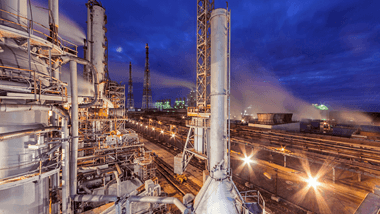 A large ammonia manufacturer in Louisiana needed a top, SIL-rated solution for measuring 300,000 lb./h of superheated steam. Legacy technology was running into issues during the steam reforming process. Byproducts were clogging internal mechanisms and transmitters often required repairs and replacement. Fortunately, the latest in vortex flow meter technology – our new Rosemount™ 8800 Quad Vortex Flow Meter – was available for a test run, and it came through for the plant in a big way.
A large ammonia manufacturer in Louisiana needed a top, SIL-rated solution for measuring 300,000 lb./h of superheated steam. Legacy technology was running into issues during the steam reforming process. Byproducts were clogging internal mechanisms and transmitters often required repairs and replacement. Fortunately, the latest in vortex flow meter technology – our new Rosemount™ 8800 Quad Vortex Flow Meter – was available for a test run, and it came through for the plant in a big way.
Bringing the Heat: Capturing Hydrogen
Ammonia is one of the most important chemicals in the world for our food supply, as it’s used to make fertilizer. Making ammonia requires both nitrogen and hydrogen. While nitrogen is relatively simple to obtain, hydrogen, however, is trickier to come by. Steam reforming is a technique that infuses natural gas, in our case, methane, with superheated steam under pressure to produce hydrogen and carbon monoxide. The hydrogen is then used in the Haber process, an industrial method for large-scale ammonia production.
Whenever processes involve these high temperatures and pressures, safety is a big concern, so the manufacturer deploys measurement devices with a specific safety integrity level (SIL). The plant was relying on four SIL-2-rated differential pressure (DP) transmitters with an orifice plate to measure the superheated steam going into this reaction. One transmitter was dedicated to controlling the steam-to-methane ratio being fed to the reformer. The other three transmitters created the safety system with a two-out-of-three (2oo3) voting configuration. If the transmitter detected too low a steam flow into the reformer, the methane gas would be cut off to prevent damage to the reformer tube.
The steam reforming process is a critical step in the production of ammonia. DP flow meters are the go-to solution when you want dependability and durability. But with carbamate salt byproduct clogging the lines, maintenance activities and costs began to escalate. The plant started looking into other technologies that could prove to be a better fit.
The Search for a Solution
Maximizing efficiency during this process is a matter of maintaining the right steam-to-methane ratio. Finding the correct balance is all about applying a precise amount of superheated steam into the system. Too little steam results in more unreacted methane and less hydrogen production. You also end up forming more carbamate salts, that unwanted byproduct that ends up plugging the lines and necessitating frequent cleaning. Even worse, you increase the risk of the reformer tube cracking, causing both a significant safety problem and, potentially, millions of dollars in production losses from a reformer tube failure. This kind of failure can take over 30 days of downtime to repair. But excess steam to the reformer is wasteful, reducing ammonia production and decreasing the plant’s thermal efficiency.
DP flow meters had the right accuracy and reliability for the task. However, the carbon deposition in the liquid-filled impulse lines plugged the high side of the differential pressure leg, even after heat tracing was applied. It was a classic case of assessment and discovery, experimenting with various solutions till the best fit is found.
SIL Capable Vortex Technology for Superheated Steam Applications
Seeking a solution that still met their SIL requirements, the plant installed an Emerson Rosemount 10-inch Quad Vortex Flow Meter upstream of the DP orifice system. The one-of-a-kind design of the Quad Vortex Flow Meter means getting SIL-rated vortex technology with two out of three voting (2oo3) in a single meter body. The flow meter has four independent transmitters and four corresponding separate sensors mounted to two shedder bars. As with the DP system, one vortex transmitter handled the control while the other three provided redundant measurement for the safety system. No moving parts and no ports or crevices meant fewer process upsets.
A two-month pilot test extended to a several months-long assessment of both technologies at the plant. The vortex flow meter did not require maintenance during the entire trial, significantly cutting operational costs and safety risks. Additionally, no unscheduled shutdowns took place. Ultimately, happy with the improvements to their process, the plant decided to keep the vortex technology, replacing the trial meter with a second Rosemount 8800 Quad Vortex Flow Meter. Read the article in Chemical Processing>
